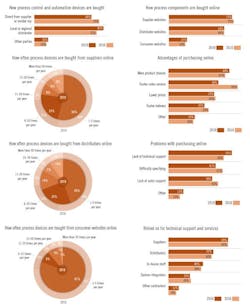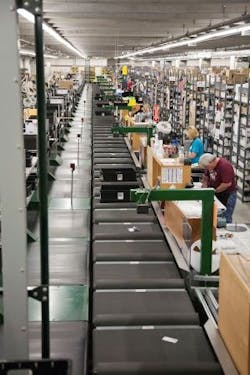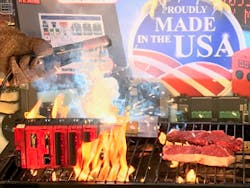eCommerce, age of instant gratification changes game for suppliers, distributors
What used to look like "being on the Internet" was just the tip of the melting iceberg. Users previously poring over PCs and the Internet are now joined at the hip to smart phones and tablets to give their teams, applications and partners constant access to the Industrial Internet of Things (IIoT), Industry 4.0, embedded and edge devices, and cloud computing services like Microsoft Azure and Amazon Web Services (AWS).
"System integrators, distributors and vendors know the most about the capabilities of their products, but it's the Internet that brings all these parties nearer to us and other customers, which makes it easier for us to communicate and make inquiries," says Mohd Azwan Bin Mohamed Raseli, instrumentation and controls engineer at Petroliam Nasional Berhad in Kuala Lumpur, Malaysia. "We deal with various materials, especially for piping/skid and other fabrications, to produce oil and gas for petrochemicals and power plants. We're employed mostly on DCSs, shutdown systems, and fire and gas systems. Whether we're buying from a distributor or direct from a supplier, we still have to properly evaluate the pros and cons of each OEM's proposals, and make judgments based on what already exists in those facilities."
These Internet-fueled trends have profoundly altered the relationships many customers have with their distributors and suppliers, as well as relations between traditional regional distributors and suppliers. Even as more recent, national distributors have emerged, they've been joined by user-driven websites for sourcing and specifying controls and other products, assisted by third-party software like Ariba. Of course, as everyone crowded onto the Internet and its new capabilities were available to all, some friction was inevitable.
"Amazon has changed the scope and expectations of buyers. Three years ago, Amazon had some influence. Buyers might use it for small items, but many mainly used their corporate accounts for purchasing. Now, Amazon is ubiquitous, and Amazon Prime sets expectations even for corporate buyers," says Gary Marchuk, business development director at AutomationDirect. "Fortunately, we pioneered e-commerce for control and automation, and continue to lead this space. We do much the same as Amazon—if a customer buys by 6 p.m., we can still ship that day."
Plus, unlike shampoo or stereo headphones that need little support, Marchuk reports that buying PLCs, variable speed drives (VFD) or servo controllers always comes with some questions about how to implement them. "Tech support is where AutomationDirect differentiates itself. We have award-winning technical support and more than 1,000 how-to videos on our available products. So, for users that need to get a safety controller to work with the associated safety software, we have 12 video on how to wire and program them," explains Marchuk. "I'd challenge any vendor to match the quality and quantity of our videos available before and after purchasing, and post sales for each of our three PLC lines, we have 75-100 software training videos about how to program and command them.
"In addition, Amazon may set expectations for purchase, but we've developed webstore tools for repeat buyers to store PLC configurations, OEM machine configurations, and bills of materials (BOM) for easy repeat purchases for similar or same applications or machines. This can drastically simplify the order process by pre-populating customers' carts with needed equipment. At the end of the day, customers still want and value expertise and service."
Evolution needs experts
What started with users going to catalogs and websites, ordering products, and waiting like mail-order recipients is quickly evolving into automated procedures tied to living bills of materials (BOM), which trigger same-day work/shipping orders to Amazon or other e-commerce hubs. These orders will come at the request of intelligent sensors and controls warning that operating components and equipment will soon wear out and require replacement. Human users will no doubt confirm many of these functions, but process monitoring, optimization and even control are going to get far more automated soon.
At first, it might seem like there's little room for people in this equation. However, during times of rapid technical change like today's take over by IIoT and digitalization, users have many questions about how to network to these functions and how to do it securely. They need local experts for answers, and they're shopping with those who can help. This was reflected in more than 110 responses this past July to Control's latest Distributors vs. Buy Direct survey, which found that:
- Almost 80% of process control and automation devices are being purchased from local or regional distributors this year, while just over 72% were bought from distributors in 2016.
- Just over 66% of process control and automation devices are being bought from suppliers or vendor representatives this year, while just over 72% bought from suppliers in 2016.
- Users buying from distributors 11 to 20 times per year jumped to 14% in 2019 from 10% in 2016, and those buying from distributors six to 10 times per year jumped to 25% in 2019 from 20% in 2016, while those buying from distributors just one to five times per year fell to 45% in 2019 from 53% in 2016 (see sidebar).
"While it's true you can get widgets from anywhere online, say bill me now, and expect them to show up right away, control valves and transmitters aren't widgets," says P. Hunter Vegas, project engineering manager of the Process Automation Group at system integrator Wunderlich-Malec in North Carolina. "When you buy process control instrumentation, it immediately forces you to make sophisticated design decisions to meet often competing requirements. You have to understand the process well enough to identify normal and abnormal conditions, and size/specify equipment to meet all of them. Unfortunately most of that process expertise is retired/retiring, and you can’t just Google or YouTube an answer."
Process control engineers, system integrators, technical professionals and other Control readers rely on many sources when they purchase controllers and all their related devices, including traditional distributors, direct from suppliers, and increasingly over the Internet and via consumer websites. In the latest 10-question survey in July 2019, more than 110 respondents reported on the most useful strategies they use to locate, specify, purchase and implement their components and support services. Click here to view the complete survey results.
Vegas acknowledges there are sizing software programs, but there are many nuances that they don't cover and younger-generation personnel don't know about. "Specifying control components with a sizing program is garbage-in, garbage-out," adds Vegas. "If you have low-flow, high-flow or cavitating conditions, but they aren't entered into the program, then you'll just get a generic answer that could result in a grossly under- or over-sized valve. Likewise, if a sizing program is only given normal pressure and temperature, it won't know the instrument will be subjected to much higher pressure/temperature conditions during clean out cycles, etc. This can result in selecting the wrong o-rings/materials of construction. In the AWS era, users are relying on engineering expertise from suppliers because experts often aren't in the plants anymore. However, suppliers can be strongly incentivized to lead with top-of-the-line instrumentation when there are much less expensive options. They also probably don't know your process and operating details."
Distribution evolution
Figure 1: One of the packing and shipping lines at Digi-Key's product distribution center in Thief River, Minn., where it stocks about 1.8 million parts, and can ship same day until 8 p.m. to customers including other regional and local distributors. The center's 2.2-million-square-foot expansion is scheduled for completion in 2021. Source: Digi-Key
Because the changes caused by digitalization and IIoT happen at the foundation of a company's procedures, they don't just affect relationships between customers, suppliers and distributors, but impact their essential characters and operations, too.
"We were a distributor and catalog house when we were established in 1972, but we took a different angle. We got online as soon as the Internet was available in the early 1990s, and switched over to it completely in 2011," says Eric Wendt, strategic program development director at Digi-Key Electronics. "There are many technical changes happening, but the Internet is the backbone of our growth. We work with a number of manufacturers, distributing their products, and got into process control and automation when they asked us. This is because our nature as a company is to supply all that's needed for a given application. We want to be a one-stop shop (Figure 1).
"For instance, there's some talk that system integrators (SI) won't be as necessary for IIoT and digitalized applications, but we think the opposite is true. As they do more big jobs, SIs can partner with companies like Digi-Key, which can basically serve as a big online warehouse for them. We can't design or setup a whole work cell, but we do have a large tech support group that goes beyond out-of-box and basic setup issues."
Wendt reports Digi-Key will soon launch a program on its website to help SIs complete projects. It will include project configurators, product selectors, visualizations and design tools for work cell layouts and other projects. "The goal is to provide a complete user experience (UE) in the format and language that users want, and allow them to narrow their choices to the products that are most appropriate for them," says Wendt. "It's important to be flexible enough to let automation do what it can for you, and then outsource that you can't do. The key going forward is find a place where we can all help each other because everyone has some strengths and skills that others don't, so we need to leverage what each individual and organization is good at because the overall ecoystem can support national suppliers, distributors, SIs and customers, too"
Cliff Ortmeyer, global head of technical marketing, Newark, reports that, "One of the largest areas of change has been driven by IIoT as customers seek to upgrade their current system, and may look across many different products to find a solution that works with their existing systems. This is and will continue to be a focus for distributors. For example, where it used to be acceptable for an online product page to have a simple title, some basic specs and a datasheet, users now expect to see much more. They need richer basic information, such as an enhanced title, multiple high-res images, features and benefits text. They also want advanced content, such as 360° images, product videos, CAD models, as well as user-generated content, including user and expert product reviews, and community/social information. As a result, distributors have to work harder on collecting, creating and serving this information."
Ortmeyer reports that Newark and Avnet have invested in technologies from top suppliers, and developed their own products and services, such as SmartEdge Agile and Avnet SmartEdge IIoT gateway, which help users find the right solutions for their needs. "Couple this with investment in software and cloud services, and customers can access a complete solution, allowing them to focus on their business and not have to invest as much in their human capital," says Ortmeyer. "Today’s customers need the best of both worlds: to work with broad-line companies offering scale, size and a global reach, while still having access to specialized capabilities for support through all stages of the product lifecycle. Companies such as Newark and Avnet can provide a broad array of products from leading suppliers to complete solutions making for a more streamlined and easier journey for customers, minimizing the need for companies to hire teams of system engineers. By partnering with an experienced partner such as Newark, smaller companies pull in the support they need at any stage with one partner, instead of having to go to multiple vendors and try to piece a system together."
Extended hours—and showmanship
Beyond offering expertise and value-added services, suppliers and distributors can also set themselves apart from Internet sources by making their know-how available during longer schedules, and even mixing in some of the showmanship exhibited by so many mainstream Internet participants.
"Everything's definitely getting more Internet-based. Many reputable manufacturers and suppliers are ramping up their online presence as customers are searching the web for what's available at a cost-effective price for their control needs," says Vikram Kumar, CEO of AVG Automation, which includes EZAutomation. "As a result, though we already have a major online presence with our factory direct, EZAutomation.net, we're further ramping up our website to simplify the selection and buying process for customers. This includes unique visual product configurators, key innovation pages, and product videos. EZAutomation's revamped website was launched in September, and is still evolving over the next couple months with added configurations tools and 3-D and 360° product videos. We're also participating in LinkedIn and Facebook, which lets visitors know more about our products and people."
In the Internet age, Kumar reports that manufacturers and distributors must maintain avenues for both older and younger-generation customers to reach them. "Though we're predominately an 'online supplier' of our own U.S.-manufactured products, we still offer the traditional, face to face and/or over-the-phone application discussions, and host lunch-and-learns. However to cater to the, younger-generation that's glued to their phones and read everything online, or just want to email back and forth, we have dedicated support staff for our online communications," explains Kumar.
Figure 2: A screen capture from EZAutomation's YouTube video demonstrates the durability of its EZRack PLC by grilling it next to a steak on a charcoal grill, and dropping on a floor to show its shock resistance. Source: EZAutomation
Even though it has many of the same Internet-based capabilities as today's distributors and suppliers, Kumar adds that EZAutomation is also a factory-direct American manufacturer that can save buyers 30-50% on its automation control products. Kumar adds there's no fear for its customers of increased prices or availability of products due to the uncertainty of trade relations with China and the ongoing tariffs being imposed on Chinese goods.
Though the trend is headed all towards the web, oftentimes end-users that don't have the controls knowledge and expertise may need to contract out with one of EZAutomation’s specialized system integrator partners that are scattered worldwide. "For example, in one recent application, a large plant used one of our SIs who is also an authorized Inductive Automation SI partner, and we worked together on the implementation and installation of 55 EZRack PLCs to be used as an edge gateway with Rockwell Automation’s ControlLogix and an edge-of-network device, so they could log data to the cloud," says Kumar. "As a result, EZAutomation was the first PLC with built-in Sparkplug B protocol produced by Cirrus Link, enabling direct communications with Inductive Automation’s Ignition Platform."
To demonstrate EZRack's durability, Kumar reports that EZAutomation also posted a video showing it "cooking" next to a steak on a charcoal grill (Figure 2).) "This was a chance to not only show the robustness of the EZRack in harsh temperature and shock conditions but to also add a little humor for control engineers watching product videos online.
Integrators bridge gaps
Not surprisingly, SIs are good at seeing the growing influence of the Internet and digitalization on supplier and distributors because they often play dual roles as customers buying products for their clients, as well as consultants giving advice on what products need to be designed and developed.
"From a system integration standpoint, the evolution of the distributor and buy online models is interesting because it affects us in multiple ways. I sit on Rockwell Automation's Solution Partner Advisory Council that works with system integrators, which is a sister to its Distributor Advisory Council, and the same trends and challenges are impacting both," says Jeremy Gibbs, sales and marketing director at Matrix Technologies Inc., a CSIA-certified system integrator in Maumee, Ohio. "When online purchasing started in the late 1990s and early 2000s, it was mainly a convenience, but wasn't seen as stealing from local distributors and sales reps.
"When next-day deliveries from suppliers and even same-day delivery from Amazon started, many more transactions shifted to online, and regular reps needed new ways to differentiate themselves by providing value-added expertise and solutions, and anticipating customers' needs instead of reacting to them. Online also got more sophisticated by offering engineered solutions that 'kitted up' by integrating dozens of parts into one product, so reps that were previously only relied on for value-added pieces like this had to get even more solutions-oriented because customers were getting accustomed to instant gratification due to consumer e-commerce."
Gibbs reports that system integrators and sales reps can work together to shift from the transactional model of the past to a consulting model that address the individual and predictive needs of customers, which can't be obtained from online sources. "Those that don't shift to consulting and stay with monthly sales quotas will struggle and fall away because customers can make regular purchases anywhere. However, those that do establish rapport and relationships will gain the trust of their clients and long-term business from them," says Gibbs. "If you can help someone meet their budget this year, then they'll probably want you to do it next year and the year after."
Similarly, Gibbs explains that distributors and SIs can also play to each other's strengths to move from selling devices per week to talking with customers about issues they're going to face in the next several months and years. "Again, just as SIs can no longer do one project and move on, distributors can't just sell individual parts because users probably already have them or can get them from somewhere else," adds Gibbs. "We emphasize account-based selling based on the individual needs of each customer, and specializing in the capabilities they need. This is a departure from trying to capture all the clients in one industry, but many distributors are using this model. We can't be chameleons and be all things to everyone because that's what the Internet does."
Gibbs adds that suppliers and distributors, as well as system integrators, must perform the difficult first step of deciding: Who they want to be? What they want to sell? Who they want their customers to be? And how they want to serve those customers? "This may cause some attrition and some former customers to be lost, but we have to focus on where we can be the most successful, even though in industrial sales it's hard to let go of anything," says Gibbs. "It was hard, but we carried out an identity program like this awhile ago, and we learned to go all in, and focus on one area. It was a rocky beginning, but it did pay off in the end.
"The second step is taking an inventory of staff and product/services lines to determine if this new mission can be supported. It's not starting a new company, but it kind of is because it's undertaking a new business. Because this is difficult, some organizations won't do it and will stick with their traditional model, but it's easy to tell who is buying in and making the switch and who isn't. Last year, we bought parts from nine distributors in three locations, and now it's just five or six distributors. However, they're still in the same number of locations because we try to buy near our clients' locations, so they'll get better long-term support."
Safe and secure
As digitalization and IIoT continue to take over, AutomationDirect's Marchuk reports the new question for vendors and distributors alike is how to make the digitalization, IIoT and their networks secure and safe?
"No one wants devices or their plant-floor exposed to the Internet, so that means segmenting networks, establishing firewalls, monitoring communications, and working with IT and cloud-computing providers to achieve cybersecurity," says Marchuk. "Many customers want to enable remote users, but they also have to be secure. We tell customers it's OK to monitor and read about production decisions and actions on a dashboard from the outside, but we advise against control from the outside the facility. IIoT can help with cybersecurity because many devices that used to be passive now have intelligence, and can add network and Internet access inexpensively to many sensors, drives and controllers."
Marchuk reports cybersecurity will become even more important as distributors and suppliers overcome former territorial and price constraints to serve larger regional and national markets, and even offer software as a service (SaaS) and other tools and programs that serve IIoT-based applications. "We also offer SaaS because, as developers come up with IIoT devices, they need data collection and cloud computing to go with them," adds Marchuk. "However, because these technologies are new, many automation engineers don't have as much of a knowledge base about the technology, and they aren't as well-versed about the methods of implementing secure Internet solutions. As a result, the challenge we have is pushing suppliers to provide greater ease of use because IIoT and security requirements aren't common knowledge for us or our customers. This is why we must all cross-train with our IT and security teams because it's new and constantly changing."
Blend models to cooperate
As users, distributors and suppliers get a little more comfortable with their new Internet tools, it appears they may also be able and willing to once again coordinate their efforts and reduce some of the recent friction between them.
"We've been in business for more than 90 years as a classic, large-catalog house with a 1,000-page book, representing hundreds of product lines, which were supported by sales offices in many U.S. cities," says Jim Davis, director of advanced solutions and technical support at Allied Electronics & Automation. "We were the first distributor to come out with our catalog on CD-ROM in the mid-1990s, and just three to five years ago, we made a major shift to an all-online catalog. We also got deep into automation, control, Industry 4.0 and IIoT, and now our website features hundreds of manufacturers. Customers can order by 9 p.m., and we can ship the same day because we have hundreds of thousands of items in our warehouse that can be sent immediately, while our offices provide support and other services."
Thanks to its online catalog and physical offices, Davis reports that Allied has developed a mixed model that combines the Internet with local presence, including work-at-homes sales reps where it doesn't have offices. Because it's a national distributor, some local distributors even use Allied as a sort of warehouse for products they may need to deliver quickly.
"Customers can buy on the Internet and get products as fast as possible, but we can also give them local representation that can understand their particular problem, and help them make sure they purchase the right products," explains Davis. "This mixed model provides a personal touch to go with buying online. Sales reps at our offices can even bring along supplier reps, which we couldn't do if we were only on the web.
"In technical fields like electronics and controls, engineers and other users need explanations about how a device works, so they can be sure it will meet their requirements. This isn't needed for the consumer goods that Amazon sells. On the other hand, Allied's customers have complex project specifications with performance metrics that determine component selection, which is why blending the capabilities of e-commerce product selection and in-person representation can take a customer's objectives and project scope, break them into design elements, and determine the most useful and cost-effective items to buy. This is why we play on both sides."
To further aid design engineers and maintenance/repair personnel, Davis reports that Allied recently added more than 25,000 images with 360° spin to its website, so viewers can rotate, tilt and zoom in on products, and make certain they're selecting the right items. "We started this about 18 months ago, and have a whole studio producing 360° spin images," adds Davis. "Young engineers tend to be more visual, so we think this will help them, and tie in with other video and social media presentations."









